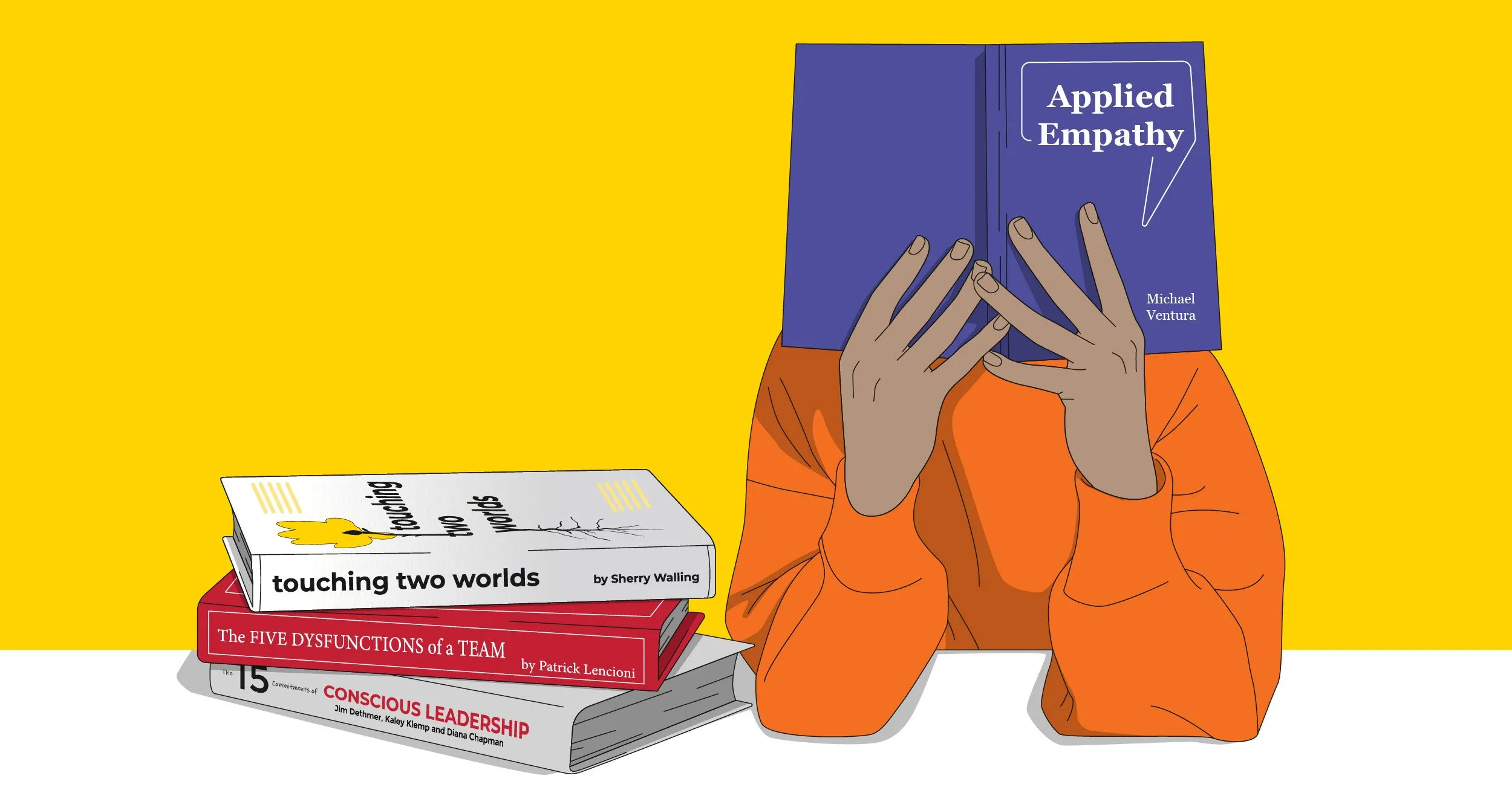The pandemic thrust organizations toward transforming work in a way that elevates our people. Let’s name the truths that really got us here, so we don’t waste the opportunity that follows.
- Reshuffle – reorganize or change the positions of
- Resign – voluntarily leave a job or position
- Reckon – to avenge or punish for past mistakes and misdeeds
If you looked at nothing more than VC updates, ecommerce figures, and subscription services, well, you’d think we were living at one of the most extraordinary times for businesses in our nation’s history.
You’d also be wrong.
That’s the thing. What you believe to be true always starts with where you choose to look, and more powerfully, what you choose as your frame of reference.
For example …
According to the Pew Research Center, on average, Americans have less wealth today than they did in 1998. If you hear this, you think Americans have stagnated.
On average, the wealthiest third of Americans have seen their incomes increase from $344,100 to $848,400 while the middle third have seen their incomes rise from $102,000 to a more modest $115,200. If you hear this, you think Americans are seeing varying levels of growth.
On average, the poorest third of Americans have seen their incomes decline from $12,300 in 1983 to $11,300 in 2016. If you hear this, you realize that the richest are getting richer faster at the expense of the poorest among us.
What you believe to be true always starts with where you choose to look, and more powerfully, what you choose as your frame of reference.
If you want to believe we’re in the midst of “The Great Reshuffle” or “The Great Resignation”, that’s what you’ll believe.
Again, you’ll also be dead wrong.
The Hard Truth About the Great Resignation / the Great Reshuffle – It’s Not One
The headlines today are pushing the concept of a massive resignation, a massive reshuffling of the workforce. Both of those statements and categorizations are massive understatements.
If you focus on current actions without context, it’s easy to paint a picture of something modest or even iterative — slap “Great” in front of it and it seems more forceful.
Most companies, most economies, likely want us to see what’s happening as an eye opening experience and a shift in priorities as a result of the pandemic because they don’t have to change how they work. Instead of hard truths, they look for excuses and reasons not to change, which leads us to narratives like:
“People valued their work-life balance more.”
“People had more time with their families and realized the value of quality time.”
“People understood the fragility of life and elevated the pursuit of happiness.”
Sure. All of the above are true. But the pandemic didn’t enlighten people as much as it became the final straw.
The pandemic didn’t open people’s eyes. It broke their backs.
What we’re seeing today is not an understated reshuffling, a modest resignation.
It’s a mother f*cking reckoning.
And it’s about time.
February 4, 2020: 4 Factors Driving Record-High Employee Engagement
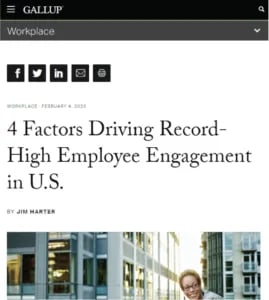
What a time and what a headline on employee engagement heading into the pandemic. Things were rosy! Was this the modern version of the “Roaring 20s” with employee engagement at record levels? Was everything really coming up Millhouse for US Workers just before the pandemic?
Yes. US Employee Engagement was at an all-time high.
And more importantly, yes. That engagement number was objectively horrible.
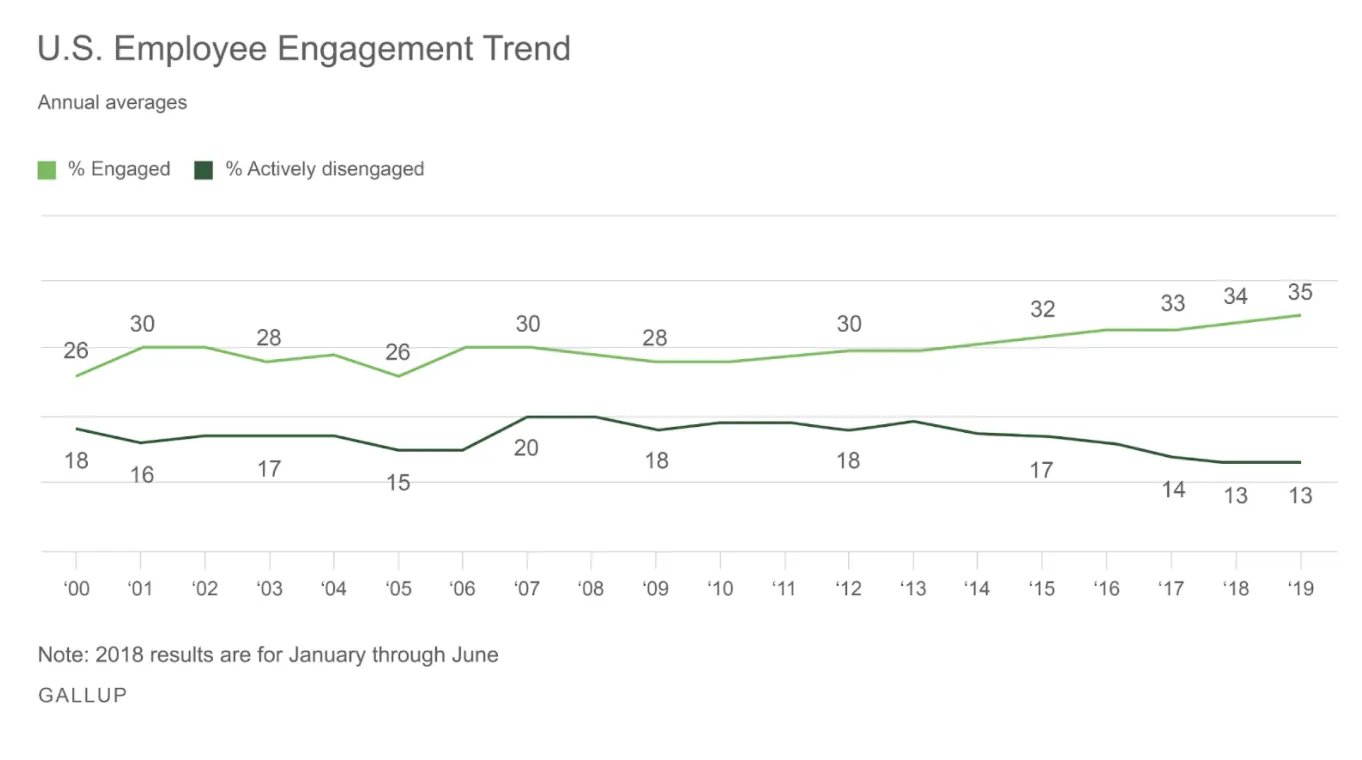
Calling what we’re experiencing a “resignation” or a “reshuffling” stops feeling right when you read this headline and then look at this data.
65% of workers weren’t engaged. That’s the hard truth. A supermajority of the workforce has been apathetic about work or disengaged from work for decades.
When we understate the condition of the US worker going into the pandemic we miss leading indicators and we miss the problem. When we miss the problem, we miss more importantly, the opportunity that’s on the other side of that hard truth.
When 65% of the people who work with you are not engaged and would rather be doing something else, their departure isn’t a resignation. It’s a realization. It’s a fragile employee base waiting for any reason to find the next thing to do. Taken one step further, the problem with framing what’s happened as a resignation or a reshuffling, makes the energy about individual actions not holistic, collective, shared experience — the problem is systemic.
When 65% of people who haven’t been engaged in over 20 years start leaving your company, it’s not a reshuffling. It’s overdue. It’s a reckoning.
(Note: Employee Engagement dropped to 20% in 2020, and has rebounded back to ~36% in 2021. Wooo. Freaking. Hooo,)
It’s not The Great Resignation, It’s the Great Reckoning
A majority of the analysis and editorials coming out on this subject are focused on people’s desire not to return to work. There are pay discussions. There are work from home realizations. There are work-life balance commentaries.
There are a bunch of narratives that obfuscate what actually happened, that allow employers to put on rose colored glasses and ignore the reckoning. Allowing these narratives to propagate without a push toward more truthful context is irresponsible.
And for employers who leave the rose-colored glasses on, it will be fatal.
There are a number of discussions on topics that are all being treated as symptoms of the reshuffle and resignation, as opposed to what they truly are: inevitable results of companies treating employees poorly for decades.
The reckoning is here because it was always coming.
35% of employees were actively engaged.
13% of employees were actively disengaged.
52% could care less.
Take the chart all the way back 21 years — all the way back to my first days in the workforce — and you’ll see that for all the engagement and disengagement, the most profound number is that at no point in the past 20 years did more than half of working Americans have a strong opinion about their work, either way.
Employee apathy hit a low in 2007, the height of the Great Recession, with 50% of people having a strong opinion (30% engaged, 20% disengaged). With a problem of this scale, we have to stop thinking about individual decisions (resigning, reshuffling) and start acknowledging the broken system.
The best we’ve done is 50% of our people at work not being apathetic (and almost half of those were worse than apathetic in some ways, they were actively disengaged).
Instead of tracking Employee Engagement, we should be tracking Employee Apathy. And realize that more than half of Americans are so disenchanted with work, they are apathetic about it.
Here comes the hardest truth: employees have every right to be apathetic. As employers, it’s our own damn fault.
More Hard Truths Underpinning The Great Reckoning
We’re hiring people for their potential. Think of the amount of effort, software, science, and training that goes into hiring these days. If you’ve ever tried to hire someone, think of the internal obstacle course you traversed to get the role defined, approved, sourced, filled and onboarded.
After all that work, we’re not giving people work that’s worthy of their experience and effort, or that makes them feel both valued and valuable.
People are opting out of working in record numbers because people aren’t certain that if they take a job, they’ll get to do their best work. (Shoutout: UiPath’s Office Worker Study is excellent work.)
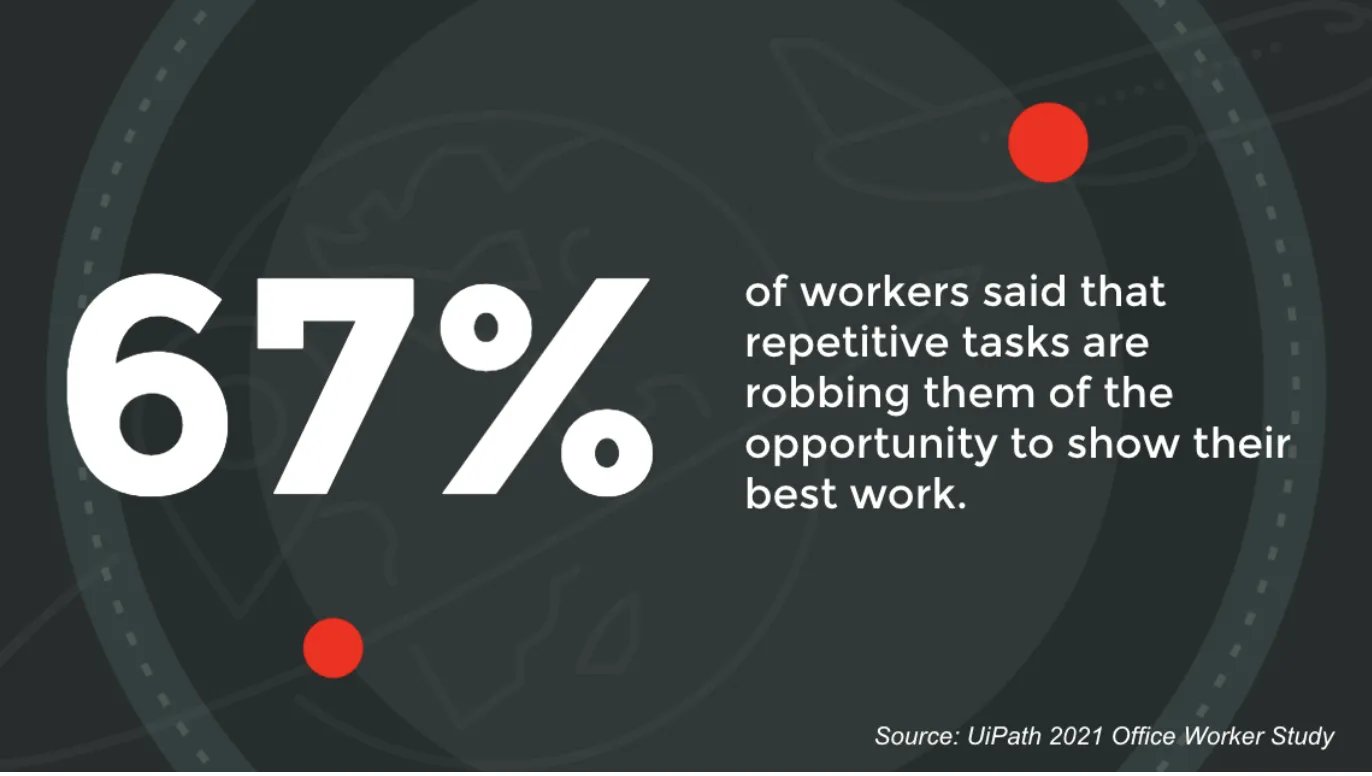
More than half of the labor force is apathetic about their work, not because they don’t want to work. Not because they want to be at home. But because they are not reaching their potential. All the skills they’ve learned, all the promise of that job description, is buried under repetitive, administrative tasks that suck the life out of their work.
It’s Time to Equip and Unleash our People at Work
People are leaving their jobs because they aren’t valued, because they aren’t achieving their potential, and because the pressure and the space COVID created compelled people to holistically rethink what matters.
The disengaged workers are likely reshuffling. But the apathetic people are the ones leaving in droves and moving on in search of their purpose. People are done going through the motions, being apathetic, and most importantly, they’re done doing work that can be automated away, or that should be.
In response, what companies need to do is help people unlock their purpose. The reason these people were hired, were promoted, were given responsibilities in the first place. And then, equip them with what they need to be their best selves, and unleash them on what you hired them to address.
If we see ourselves as in the midst of a reshuffle, we’ll see this as people moving between places. The emphasis here is on changing and switching, not on rejecting and disavowing.
If we see ourselves as in the midst of a resignation, we’ll see this as people stepping back from their work. The emphasis here is on what they’re leaving, not what they’re pursuing.
Both miss the point greatly.
At the time of writing this post, 4.2 million people left their jobs (October, 2021), which was 2.8% of the total US workforce. This was just below the record of 4.4 million … from September (yeah, the month just before).
All those people quit while 11 million job openings were left unfilled. The facts don’t support the understated narratives that have been propagated.
Per Theresa Sheehan of Econoday:
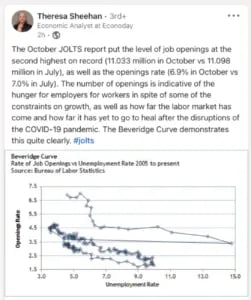
Employers are hungry for people. People aren’t that hungry for what employers are serving. People aren’t reshuffling, because the work we’re offering people isn’t any good. It hasn’t been for a long time, but now, employees are calling our bluff.
Adapt or perish. But to be clear, companies can’t wait this trend out for multiple reasons.
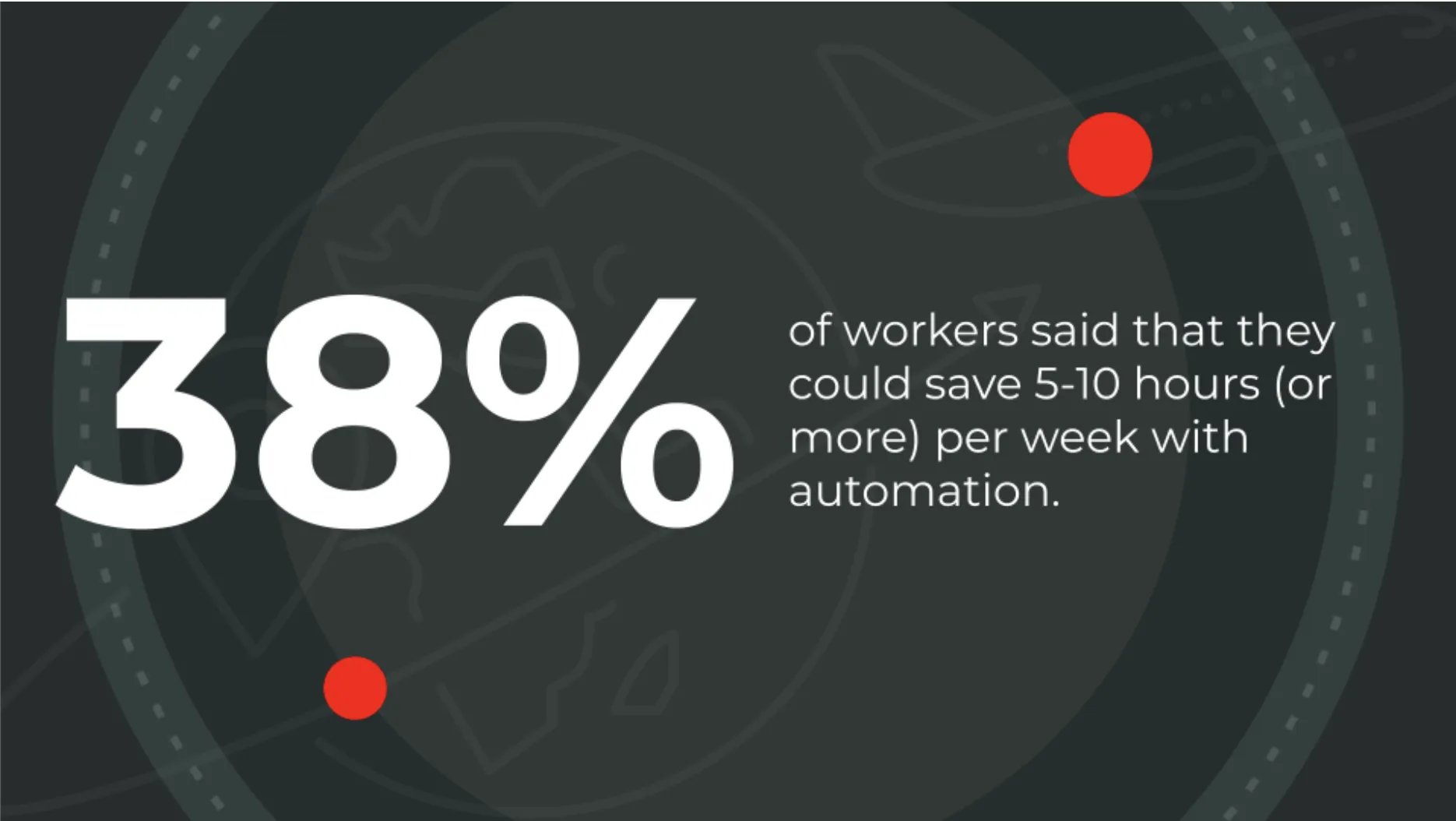
38% of workers could save the equivalent of a full business day with the implementation of smart processes and technologies. The result is a clear increase in productivity (getting some hours back), and also, a compounded one.
Removing automatable work from the workday improves energy and engagement overall and therefore, makes the other hours worked, more productive as well.
What’s good for our people at work, is good for the employer, too. You’ll gain 5-10 hours of work from each team member, and the remaining 30-35 hours will be done with greater energy, passion and commitment.
This is the transformative opportunity in front of us. What people work on, as well as, how people work.
Show me those Gallup poll numbers when we all prioritize equipping and unleashing our people and I’ll show you a real headline worth writing.
Pay Attention to What’s Consuming your Attention
The number that is worth discussing going into the pandemic? The lowest poverty rate in US history, 10.5%, occurred in 2019 as we headed into the pandemic. Salaries were on the rise. Another celebratory moment?
Again. It depends where you look.
In aggregate the trends were powerful, but low-wage workers — 44.6% of American workers — were making on average $10.22/hour. People were working (3.6% unemployment in Q4 2019 tells that story), but “they mask the longer run changes under the surface that [were] splitting the labor market and trapping low wage workers.”
There’s more.
“We find low-wage workers are the most likely to remain stuck in their wage bracket when they switch occupations.”
That’s still not it.
“But even workers in the middle class are more likely to move down the occupational ladder than up.”
We didn’t have it right going into the pandemic. And we were running in the wrong direction.
Instead of putting our people on our shoulders and equipping them to reach new heights and be their best selves, we flipped the orientation, and built our economy (our bank accounts, our nest eggs) on their backs.
We trapped them. We underpaid them. We gave them work below their skills, wants, and training.
When they started to leave us behind, sometimes seeking no work instead of working for us, we spit shined the feedback and said “it’s because they want to work from home.”
We’re not letting ourselves hear the hard truths, and that’s why people continue to leave work in record numbers.
At Boldr, people are central to our mission, vision, values, purpose — to all that we do. Our people are the atomic unit of our business. Boldr is also far and away the most people-focused business I have been a part of. Some can say it’s based on the nature of our business, as the value we bring to our clients is based on the people we find and hire to work with our clients.
That logic is why businesses like ours are people-based; being people-focused, however, is different. It’s more.
If you work at Boldr or talk to our Founder, you know that we have always been obsessively people-focused. Boldr started because there was a belief that you could build better teams for clients if you focused on treating the people on those teams better.
We don’t always get it right. Being people-focused means getting to the heart of the mistakes we’ve made when equipping and unleashing our people to be their best selves. It means cutting through the easy answers to find the hard truths.
Finding those hard truths is rewarding. Because the greatest opportunities to do our best work and be our best selves, lie in a space just past those hard truths. Don’t believe me, ask Will Smith.
When it comes to talking about what’s happened in the workforce since the pandemic, well, I don’t think we’re telling ourselves the hard truth. And it’s about to be a problem.
As a people-focused business, we’ve paid extra special attention to the workforce during the pandemic. Our clients have turned to us for everything from advice to partnerships. Advice falls mainly on how to manage changing organizational models and staffing needs, while on partnerships, we’ve had more and more clients asking for help finding global talent in the face of a tightening labor market and rising expectations around wages, work-life balance, and meaningful work.
It is this experience that inspires my near visceral reaction every time I read a headline that takes this incredible moment we’re in, about the transformation and evolution of work — and then downplay it by calling it a “reshuffling” or a “resignation”.
What are your Priorities in Times of Crisis and Opportunity?
If we don’t look at what preceded the reshuffle and resignation; if we don’t realize the surge before the swell, we’re going to miss this opportunity to do transformational and amazing things around how people work, what people work on, and how people are valued.
(Note: For those of you who don’t know, Boldr is a purpose-driven outsourcing company that helps our clients and partners rethink what can be outsourced and what outsourcing can be by focusing on giving our Team Members careers instead of jobs, by helping our clients build teams not just complete tasks, and by reinvesting our time and money into the communities where we live and work.)
When the pandemic started, while everyone else was talking through how to manage cash, how to stay in business, and what strategies to deploy; I pushed our team at Boldr to focus in a very different and counterintuitive manner: to prioritize (1a) Team Member health and safety and (1b) Client health and success. Revenue and performance be damned.
While everyone was talking about The Great Layoff, we were talking about The Great Reprofiling. Taking Team Members with different backgrounds, experiences, life stages, and reprofiling them for new work. Helping them find opportunities connected more directly to Boldr’s revenue and outcomes so they maintained job security and ultimately, peace of mind, at the most uncertain of times.
The Great Layoff came and went. The industries we worked with recovered quickly and then, took rapid flight. Experiencing growth rates that were incredible while the disconnect between these emerging growth industries and companies and what most of the world was experiencing was its own kind of incredible (read: leaving entire populations sadly, behind).
Things were going incredibly well for some. Things were going extraordinarily poorly for others. It all went back to what people were paying attention to.
If you paid attention to the system holistically, you realized the hard truth was that the system is broken. If you got there, you likely also saw that improving how we equip and unleash our people at work, is the transformational opportunity right in front of our noses.
Higher Expectations, Changing Business Models, and “The Person at Work”
The world has changed. The way we work, still hasn’t. It only took a sustained, global pandemic to finally cut the tension.
At Boldr, we’re seeing the tension first-hand. We have a client in the Fortune 1000 who connected with us this year because they cannot find people to do the jobs they used to do at $18/hour, at $30/hour today.
The problem is not going away, it’s coming home to roost.
Business models will be forced to evolve and change, focused on paying fairer wages to their employees objectively but also, correlated to the work they produce and the experience and skills they bring to the table. This will undeniably cascade from expense lines to commercialization models and pricing (we’ll create more meaningful work, products, and services, and have less space for the disposable).
For companies, we no longer have workers or employees (FWIW, at Boldr, we have Team Members); you’re at the bleeding edge of the rise of the person at work. People at work. And all of the emerging trends we’re seeing — remote work, benefits, flexible schedules, learning and development, mental health benefits — point to the fact that the people who do the work are going to do it on their terms and in environments of their choosing.
The inverse of this, is the walls we had previously put up as employers that forced people to engage — show up at work, stay tethered to your desk, be happy with having work (and not with the work you have), you can’t take your healthcare with you — the list goes on. So many of the walls and chains and tethers we used to force people to stay at work are crumbling. Employers can no longer trip people in and make it hard to climb out. We have to focus on inspiring people to join and compelling our people to stay.
Fundamental to all of this: people want to feel like the work they do is a reflection of their best selves, and equips and unleashes them to be their best selves. They don’t want to feel like workers. They want to feel like themselves, their best selves, at work.
How do you address this sort of progress so you don’t regress?
There’s Tremendous Hope and Opportunity on the Other Side of this Hard Truth
You address it by first acknowledging it.
Like all things, if we acknowledge this hard truth, the opportunities that become available to us are incredible. In this case, it’s the opportunity to build teams and organizations held together not by seating charts and dress code mandates, but by shared values, a sense of individual meaning and purpose that aligns with the work done and the goals pursued. These ties bind more naturally and more sustainably.
People resign from bad bosses. People are resigned to uphold their values.
People reshuffle from bad commutes to bad jobs. People reshuffle their days to get meaningful work done.
On the other side of these hard truths is the next economy; one that celebrates the rise of the person at work.
As employers, we’re equipped to embrace this transition. The roadmap is objectively clear as are the benefits of embracing and the repercussions of not.
To invest in tools, in resources, in training and development, in career paths, that make sure 67% of our people at work don’t feel robbed of time by repetitive tasks someone else may find meaningful, or some other tool may be able to carry forward so our people at work are elevated.
To realize how wasteful we’re being when nearly half of our people at work feel like there’s an easy way for them to increase their productivity 20%, if someone would just stop, listen, and frankly, do the math on what’s holding us back from being our best, selves and company.
When we equip and unleash the atomic unit of our businesses — this is always our people, if that hasn’t hit you yet — only then can we equip and unleash more powerful systems, built on collaboration and collective work. (This is a thread we’ll pull on at a different time, ideally with the help of some incredible thinkers in the space, like Pratiksha Patel of CB Insights, who are wrapping their heads and arms around this opportunity.)
What are you doing to support and elevate your teams and your people? It’s a question we will all be asking each other, and our people at work, more rigorously and more authentically, because we know it’s now more important than anything else.
As we enter 2022, we’re eager to partner with our clients to create opportunities for them to elevate their teams. We’ll have more to say on this in the coming months (stay tuned!)
There is one thing we need to get out of the way now, though.
As we enter 2022, we promise our Team Members that we will not take these trends for granted. You deserve our best so you can be and feel your best.
And our best is what you’ll have.
I reckon, it’s time.
A Quick Thank You: I want to thank Cassandra Naji of Animalz, Pratiksha Patel of CB Insights, Mandy Sebel of Radian Capital and Jillian Powers of Cognizant for taking the time to be a sounding board for this. I’ve had these concepts in my head since March, and finally decided to pour these thoughts out into a Google Doc. Cassandra, Pratiksha, Mandy and Jillian took the time to sift through an initial stream of consciousness and bring greater structure, weight and perspective to the piece. I appreciate you.


